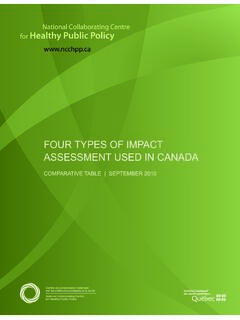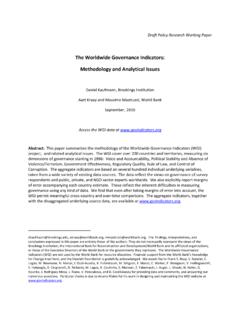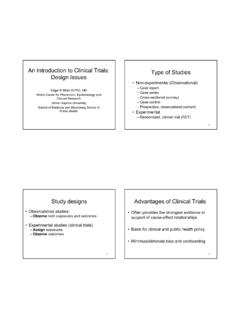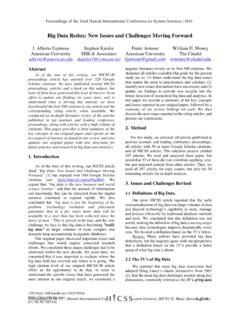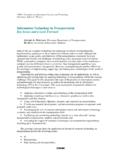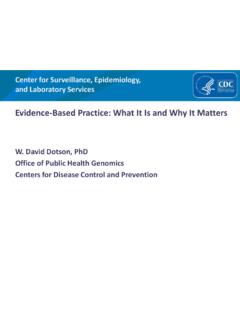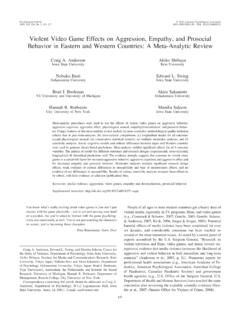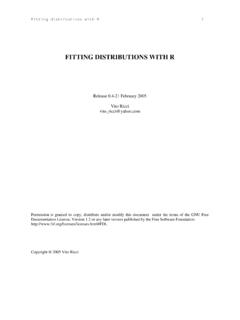Transcription of A Framework for Analyzing Public Policies: Practical Guide
1 Briefing NoteFor up-to-date knowledge relating to healthy Public policyA Framework for Analyzing Public Policies: Practical Guide September 2012 Public health actors in Public , community and academic networks may be called upon to work on Public policies and, within the context of this work, to interact with policy makers at different levels (municipal, provincial, etc.). However, they often find that the content of their discourse does not meet all the information needs of these decision makers. This document presents a structured process based on an analytical Framework that reflects a Public health perspective, while at the same time integrating other concerns of policy makers. The document addresses four questions: What Public policies does this analytical Framework apply to?
2 In what types of situations is it useful? Which policy facets does it focus on? How is the analysis carried out? An analytical Framework for what type of Public policy? Public policy here refers to a strategic action led by a Public authority in order to limit or increase the presence of certain phenomena within the population (National Collaborating Centre for Healthy Public Policy [NCCHPP], 2012). More specifically, the proposed Framework is designed to analyze healthy (or presumed to be healthy) Public policies. Definition of healthy Public policy proposed by Milio (2001, p. 622): Healthy Public policy improves the conditions under which people live: secure, safe, adequate and sustainable livelihoods, lifestyles, and environments, including, housing, education, nutrition, information exchange, child care, transportation, and necessary community and personal social and health services.
3 Healthy Public policies can be generated by and implemented in various sectors. Their expected impact on health derives from their impact on living conditions, which in turn strongly influence health. Carrying out an analysis of Public policies: in which situations is this useful? Usually, Public health actors do not have the power to make Public policy decisions, and they represent only one voice among many: policy making is influenced by numerous groups and organizations with an interest in the outcome (Milio, 2001). It is therefore important to present the Public health perspective while remaining aware of the other perspectives being expressed and how these may resonate with policy makers. Given this context, the analysis of Public policies proves useful, particularly in the following situations: 1) Before the decision to adopt a Public policy is made There are several possible scenarios: You must inform a decision maker about the relevance of adopting a particular Public policy.
4 You do not have a particular bias with regard to this policy and the aim is simply to provide the decision maker with the information needed to make an informed decision. The proposed Framework allows for such a structured analysis. To address a Public health problem, you wish to promote the adoption of a Public policy; you are thus consciously playing the role of advocate, guided by your organization s mission. Applying the analytical Framework to the policy clarifies its implications, which helps you prepare your supporting arguments and advocacy strategy. You wish to compare Public policies. The goal may be to inform the decision-making process when there are several competing options, or earlier in the process, to decide Tel: 514 864-1600 ext.
5 3615 Fax: 514 864-5180 Email: Briefing Note A Framework for Analyzing Public Policies: Practical Guide which policy should be the focus of in-depth study or of advocacy efforts (such a reflection is useful when resources are limited). The analytical Framework provides a common structure for summarizing the advantages and limitations of the proposed policies, with regard to various aspects relevant to decision making. 2) To analyze a policy already being implemented You are required to evaluate a Public policy, for example, to help determine whether or not it should be prolonged or to identify its weaknesses so they can be corrected. An evaluation could focus on many aspects; the analytical Framework presents a range of possible evaluation questions, from among which those most relevant to the context at hand may be chosen.
6 What do we want to know about the Public policy under study? Description of the analytical Framework In the field of Public health, the evidence-informed approach to decision making has been favoured. This approach places emphasis on examining the effectiveness of the options being considered. Similarly, many governments have set out to analyze policies and programs to determine what works (Nutley, Walter, & Davies, 2007). Issues related to the implementation of a Public policy must also be identified so that its chances of success can be assessed and its implementation properly planned. Data related to this topic are even more sought after by policy makers, who are held accountable and are subject to various pressures, which accounts for their concern to anticipate how stakeholders are likely to react to a given policy.
7 Thus the need for a two-pronged analysis, focused at once on the effects of the policy being studied and on the issues surrounding its implementation. Drawing on work in the field of political science (Salamon, 2002) and on policies aimed at combating obesity (Swinburn, Gill, & Kumanyika, 2005), we have broken down these two axes into six analytical dimensions that influence decision-making about Public policies (Table 1): effectiveness, unintended effects, equity, cost, feasibility and acceptability. The question of durability, that is, the capacity to be sustained over time, cuts across all six dimensions. In concrete terms, this means documenting the capacity of the policy being studied to remain in effect and to continue producing effects over time.
8 To Guide the analysis, we have specified, for each dimension, specific elements that should be considered and these are presented 1 See the Appendix for a summary list in the form of questions to be asked. Table 1 Dimensions for Analyzing Public policies Effects Effectiveness What effects does the policy have on the targeted health problem? D u r a b i l i t y Unintended effects What are the unintended effects of this policy? Equity What are the effects of this policy on different groups? Implementation Cost What is the financial cost of this policy? Feasibility Is this policy technically feasible? Acceptability Do the relevant stakeholders view the policy as acceptable? Tel: 514 864-1600 ext.
9 3615 Fax: 514 864-5180 Email: Note 3 A Framework for Analyzing Public Policies: Practical Guide Figure 1 Example of a Public policy logic model: Nutrition labelling INTERMEDIATE EFFECTS Public POLICY ULTIMATE EFFECT ON THE PROBLEM Purchase of healthier foods Nutrition labelling Prevention of obesity Healthier diet Read by consumers Well understood Better-informed consumers EFFECTIVENESS The first element used to assess the success of a Public policy is its effectiveness at achieving its objective (Salamon, 2002); in the case of healthy Public policies, the objective is to prevent or remedy a health problem, or to otherwise promote health. It is also necessary to report a possible absence of effects, or negative effects of the policy under study that would aggravate the targeted of negative effectiveness : if banning the sale of certain substances to minors (alcohol, tobacco), instead of reducing consumption by this group, increases consumption because some adolescents are attracted by the forbidden.
10 However, it is often difficult to judge the ultimate effects of a policy: it can take time before they can be observed; moreover, it is not easy to prove the existence of a cause and effect relationship because Public policies represent only one of a multitude of factors that simultaneously influence the targeted problem (Milton, Moonan, Taylor-Robinson, & Whitehead, 2011). In addition, published evidence examining the link between Public policies and their ultimate effects is scarce. Hence the value of taking into account intermediate effects. To do so, it is necessary to deconstruct the chain of expected effects between the Public policy under study and the targeted problem. A useful way to visualize this chain of effects is to represent it in the form of a logic 2 These neutral or negative effects are recorded under the "Effectiveness" dimension because they are measured against the objective being pursued by the policy under study.





